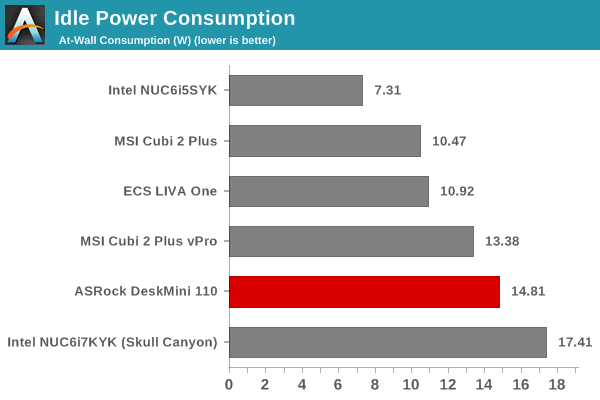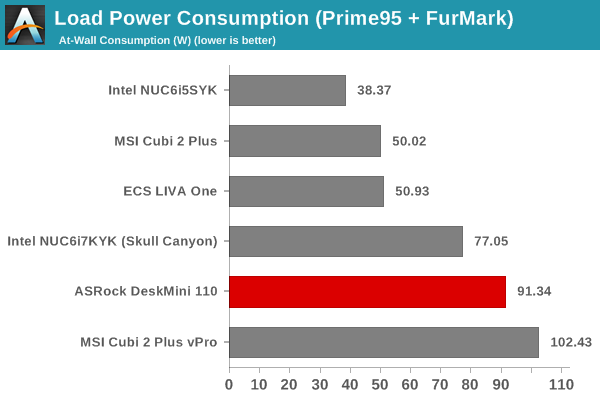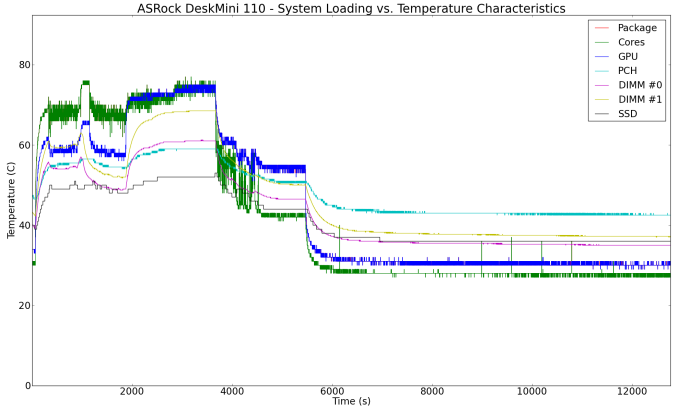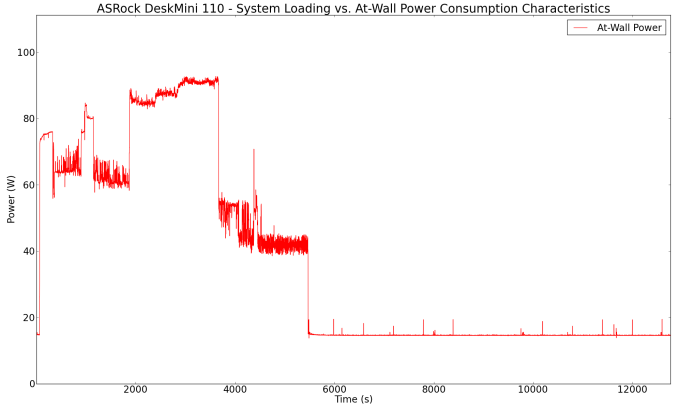ASRock DeskMini 110 mini-STX PC Review
by Ganesh T S on June 8, 2016 8:45 AM ESTPower Consumption and Thermal Performance
The power consumption at the wall was measured with a 1080p display being driven through the HDMI port. In the graphs below, we compare the idle and load power of the ASRock DeskMini 110 with other low power PCs evaluated before. For load power consumption, we ran Furmark 1.12.0 and Prime95 v27.9 together. The numbers are what one might expect for the combination of hardware components in the machine.


Our thermal stress routine starts with the system at idle, followed by 30 minutes of pure CPU loading. This is followed by another 30 minutes of both CPU and GPU being loaded simultaneously. After this, the CPU load gets removed, allowing the GPU to be loaded alone for another 30 minutes. The various clocks in the system as well as the temperatures within the unit are presented below.
According to the official specifications, the Tcase of the Core i5-6500 is 71C, and the BIOS performance curves are set to ensure that the processor doesn't go beyond that even under stress. Therefore, we see very strange package power / at-wall power consumption in the pure CPU loading case. However, things do stabilize at a higher power number when both the CPU and the GPU are loaded together.
Another important aspect to keep note of while evaluating small form-factor PCs is the chassis temperature. Using the Android version of the FLIR One thermal imager, we observed the chassis temperature after the CPU package temperature reached the steady state value in the above graph.
We have additional thermal images in the gallery below. The chassis temperatures are not a big concern even under extreme loading conditions.





















85 Comments
View All Comments
dj_aris - Wednesday, June 8, 2016 - link
What if mini-STX boards came with an MXM slot? That would spawn a really fresh and interesting form factor...DanNeely - Wednesday, June 8, 2016 - link
Unless the OEM was also able to solve the problem of MXM cards not being readily available on the aftermarket (and what is available tending to be obscenely priced) I suspect it'd be more likely to spawn frustration and rage.bill.rookard - Wednesday, June 8, 2016 - link
Well, that's the point of putting it out there. If you make it available, and people do start to use it, companies will start to produce boards for it, competition ensues, prices drop and availability goes up.nathanddrews - Wednesday, June 8, 2016 - link
But MXM has been available for over a decade (laptops) and it hasn't helped anything. I still remember trying to upgrade my Dell laptop to a 7950GTX and the MXM chip was $900 on eBay. even now, the 980M is over $800. If it hasn't caught on by now...xchaotic - Wednesday, June 8, 2016 - link
Basically MXM, if priced exactly the same as desktop PCIE boards should give vendors more margin. So IMO MXM should be prices identically to their big cousins and that wouldn't be bad for both consumers and OEMswolrah - Wednesday, June 8, 2016 - link
Except that it would make no sense for them to be priced the same considering the same parts would have to be packed much more densely in to the MXM board compared to a desktop board.That's like saying a laptop should be the same price as a comparable desktop + monitor + keyboard + touchpad.
xenol - Wednesday, June 8, 2016 - link
Probably the reason why MXM boards are so expensive is that there are no official markets for them. People complain why Mini-ITX boards can be as pricey as ATX boards or why SFX power supplies are as pricey as ATX ones. They're probably pricey because there's a niche demand for them (though I'd argue mITX boards tend to have more core features than ATX ones)Morawka - Wednesday, June 8, 2016 - link
No cooling fan, no heatsink, no display outputs, reduced bill of materialsNamisecond - Wednesday, July 6, 2016 - link
You're asking for 80 square inches of board real estate to be miniaturized and crammed into about 5., and then to be sold at the same rate as that bigger item.You may as well demand all labor to be priced at the same rate as that of a Shenzhen assembly line worker.
barleyguy - Wednesday, June 8, 2016 - link
I had an Asus laptop with an MXM slot. The major problem there was compatibility. Asus put custom firmware on the boards that was required for the computer to function. Basically the first 512K (I think) of the firmware was Asus specific, and the remaining part came from NVidia.I think that's been the issue with MXM all along: You can't just buy any laptop with the slot, buy any card for the slot, and expect it to work without serious technical wizardry.
Low profile PCI Express probably makes more sense. It wouldn't greatly increase the size of a box like this.